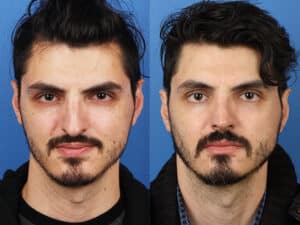Your Deviated Septum: Causes, Effects and Treatments

What Is a Deviated Septum?
Inside the nose, the nasal passages are separated by a small, delicate piece of cartilage. When this cartilage is straight, both airways are unobstructed and capable of breathing in equal amounts of air. A deviated septum occurs when this cartilage is misaligned. It can result in imbalanced or difficult breathing, sinus drainage problems, and even trouble sleeping. An estimated 80 percent of people have a deviated septum to some degree, many of whom do not know it.
What Causes a Deviated Septum?
Most of those who have a deviated septum are born with it. In other cases, trauma or injury to the nose can result in a deviated septum. Whatever has caused this condition, the symptoms will be the same. If you have experienced any of the following issues, you may have a deviated septum:
- Chronic nasal congestion, typically with one size being more congested than the other
- Difficulty breathing
- Recurring sinus infections
- Frequent nosebleeds
- Facial pain around the nose and sinus cavities
- Frequent headaches
- Postnasal drip
- Loud breathing or snoring when sleeping, sometimes causing sleep apnea
How Is a Deviated Septum Treated?
When a deviated septum is causing moderate or severe symptoms, treatment is necessary to achieve some relief. In some milder cases, medication can provide a temporary solution, but the only real way to address the underlying problem is with a special nasal surgery called septoplasty.
A septoplasty surgery is a type of rhinoplasty that focuses on the internal workings of the nose, specifically the correction of a misaligned septum. During this procedure, your facial plastic surgeon makes a small incision to gain access to the inside of the nose. The specifics of your septoplasty will depend largely on what has caused the imbalance of your nasal passageways. In some cases, the cartilage can be adjusted and in other cases, your septum needs to be reduced in size to alleviate the trouble.
After your nose surgery, you may be sent home with internal splints or other supports to stabilize the septum as it heals. Very minimal swelling or bruising will result if only your septum has been altered during surgery. Many patients opt to make aesthetic changes to the nose as well, making septoplasty a small part of their full rhinoplasty procedure. You should be at least 16-17 years old to be considered for septoplasty surgery to ensure that your nose is fully mature. To learn more about septoplasty, visit medlineplus.gov.
Learn More About Septoplasty From a Facial Plastic Surgeon
Septoplasty can greatly improve your breathing and sinus troubles, especially if you are considered a good candidate for the procedure. To get more specific information on how this surgery can help you, book a consultation with the right facial plastic surgeon today. He can provide more in-depth knowledge about the nasal surgery process, from preparation to the rhinoplasty healing process. Dr. Philip Miller has specialized exclusively in facial plastic surgery for over 20 years and has the experience and knowledge to offer the best results to his patients.
A recognized rhinoplasty expert, Dr. Miller has been frequently invited to share his specific techniques with his peers at various national facial plastic surgery conferences. He has been voted among the Best Doctors in America each year since 2007 and has also been named a Top Doctor of New York. To schedule a consultation with Dr. Miller, contact his facial plastic surgery office located at 60 East 56th Street, Third Floor in New York City, by calling (646) 791-3025.
Next, learn Why Realistic Expectations Matter
What You Need to Know About Male Rhinoplasty

How Are Male Patients Assessed as Candidates for Rhinoplasty?
Before you can schedule a rhinoplasty surgery, your nose must be fully mature. If your nose is still growing, you will have problems with your results changing over time. Once your nose is set in its adult shape and size, rhinoplasty can make life-long changes and achieve the results you want to see. Nasal maturity usually occurs in the teen years, typically around 15 to 17 years old for male patients.
Beyond your age and nasal maturity, all patients of rhinoplasty should be in good overall health without any conditions or lifestyle factors that could delay healing. You should also be a nonsmoker to avoid potentially harmful complications during and after surgery. Finally, you should have a reasonable expectation for your own rhinoplasty results to ensure your satisfaction at the end of your recovery period. If you’re not sure if you would make a good candidate for rhinoplasty, meet with an experienced facial plastic surgeon like Dr. Miller to get his or her opinion.
Do Differences Exist Between the Male and Female Nose?
Every nose, every patient, and every rhinoplasty is unique, but there are some characteristics shared among men and others shared among women. Most noses are similar in structure, but preferences in outcomes usually differ.
On average, male patients also tend to have thicker and more vascular skin. As a result, careful measures must be taken to penetrate the skin of the male nose without causing excessive bleeding or fluid retention after surgery.
Finally, many men considering rhinoplasty may have injuries from sports activities, childhood accidents, and other injuries. A higher percentage of male patients have deviated septums, past breakages, and other problems as a result, including breathing issues. For this reason, many male rhinoplasty surgeries will work to alter the appearance of the nose while improving its function at the same time.
How Are Male Patients Psychologically Affected by Rhinoplasty?
Men who are approaching the rhinoplasty process may have different psychological considerations than female patients. It is not as common a procedure among men, especially for cosmetic reasons, and that can lead to doubts, embarrassment, and other negative emotions. As a male rhinoplasty patient, it’s important to focus on the benefits you will receive from your surgery, including an improved appearance and boost of self-confidence because of your new look.
Plan a Rhinoplasty at New York’s Top Plastic Surgery Clinic
Both men and women can benefit from the changes possible through rhinoplasty. To get more specific information on how this surgery can help you, book a consultation with the right facial plastic surgeon today. He can provide more in-depth knowledge about the nasal surgery process. Dr. Philip Miller has specialized exclusively in facial plastic surgery for over 20.
A recognized expert in rhinoplasty, Dr. Miller has been frequently invited to share his specific techniques with his peers at various national facial plastic surgery conventions. He has been voted among the Best Doctors in America each year since 2007 and has also been named a Top Doctor of New York. To schedule a consultation with Dr. Miller, contact his plastic surgery clinic located at 60 East 56th Street, Third Floor in New York City, by calling (646) 791-3025.
There’s No Shame In Rhinoplasty

Despite the many advances made in rhinoplasty techniques and medical technology, a stigma still surrounds “nose jobs.” Even this term seems to undermine the value that can be found in refining or reshaping the nasal structure. If you’re planning a rhinoplasty surgery or have been a patient recently, it’s time to be proud of the well-crafted results of your nose job and stop being ashamed.
Why Does the Stigma Exist?
The stigma of rhinoplasty is tough to trace back to its roots. It seems that everyday women and Hollywood starlets alike have gone to great lengths to cover up rhinoplasty surgeries from their loved ones and the public eye. Many patients choose subtle changes to achieve their results without drawing too much attention. Others use other methods to distract from their nasal changes, like a new hairstyle or makeup look. We’re so happy to reinvent ourselves through our fashion, our careers, and even our personal lives, but not through a helpful cosmetic surgery like rhinoplasty. Where does this come from?
Only speculation can answer this question. Some of the possible reasons could include:
- Social rejection for anyone who changes what nature has given us.
- Familial rejection because of changes to hereditary nasal characteristics.
- The idea that surgery is a “cheap” way to “buy” beauty.
- Jealousy of others who have not sought the procedure for themselves, either because of fear or financial difficulty.
What Are Your Reasons for Surgery?
There is an obvious disconnect between the reasons patients seek rhinoplasty surgery and the reasons they are judged for it. The vast majority of prospective rhinoplasty patients are looking for a way to balance their facial features, improve their self-confidence, reverse damage from a previous nasal trauma, resolve functional problems, or just achieve the nose they’ve always wanted to have. These reasons are genuine and very personal. Ultimately, your choice to have rhinoplasty surgery is yours alone and those who would judge you cannot truly know your motivations. Consult with a board certified facial plastic surgeon to create the right surgical plan that can help you to create facial harmony among your nose and other features.
How Can You Be Proud of Your Rhinoplasty Results?
The choice is up to you whether you will hide your results or embrace these beautiful changes. Rhinoplasty surgery can boost your self-image and end years of hiding from the camera, avoiding mirrors, and listening to the insults of others. Rhinoplasty can resize a nose that is too big or small, reshape a pointy or bulbous nasal tip, remove a bump or hump from the nasal bridge, and much more. Some of these aesthetic concerns can interfere with your happiness, self-worth, and other areas of your life.
If you’re not sure how to tell others about your rhinoplasty surgery, consider these helpful tips:
- Talk about your surgical plans ahead of time with your loved ones, individually or as a group.
- Don’t be too specific about the details unless you are asked.
- Be open about your motivations for surgery so they understand how much thought has gone into this personal choice.
- Be sensitive that your family members might be insulted if you talk negatively about nasal features you share. Stick to the basics and don’t offend them, especially if they’re opting not to make surgical changes of their own.
- Don’t be defensive. Not everyone will understand your choice, but remember that it is yours to make. Don’t be pulled into an argument if a loved one doesn’t support your choice initially. Make the decision that is right for you and respect that others will choose differently for themselves.
Even the simplest choices we make in life, from drinking a latte late at night to trying a bold new hair color, can stir reactions in those who care about us. Trust that your loved ones will ultimately be there to support you in the end. Be proud of the results that you can achieve with rhinoplasty surgery and the happiness you will experience as a result. To learn more about rhinoplasty, visit medlineplus.gov
Consult With a New York Rhinoplasty Specialist to Plan Your Procedure
To achieve rhinoplasty results you can be proud of, book a consultation with the right facial plastic surgeon today. He can provide more in-depth knowledge about the nasal surgery process. Dr. Philip Miller has specialized exclusively in facial plastic surgery and offers over 20 years of experience and knowledge to his patients.
A recognized expert in rhinoplasty, Dr. Miller has been frequently invited to share his specific techniques with his peers at various national facial plastic surgery meetings. He has been voted among the Best Doctors in America each year since 2007 and has also been named a Top Doctor of New York. To schedule a consultation with Dr. Miller, contact his office located at 60 East 56th Street, Third Floor in New York City, by calling (646) 791-3025.
Next, here’s everything you need to know about male rhinoplasty
Ten Things to Avoid After Rhinoplasty Surgery

A rhinoplasty procedure can give you results that are dramatic, satisfying, and very positive. But the surgery is just half the battle. Once you’ve left the operating room to head home and begin your recovery, maintaining these new changes and actualizing these results will be all up to you. While each person will recover at a different pace, you have a hand at making your road to recovery much smoother, without any complications, unwanted side effects, or delays. Learn about the things you must avoid in order to achieve the nose job results you truly desire and to feel better as quickly as possible.
#1 – Strenuous Activities
While recovering from your rhinoplasty, you must avoid any strenuous activities like high impact exercising, heavy lifting, and anything that involves vigorous movement. There are several reasons to avoid these activities. Firstly, the excess blood flow to the face can increase swelling and even put you at risk for bleeding. Secondly, your sweat can compromise the healing process of your skin. Lastly, vigorous or strenuous activities can put you at risk for damage to the nose. When your nose is healing from surgery, the bones are often not set, making it more susceptible to damage, breakage, and shifting.
#2 – Blowing Your Nose
Allergies, colds, and the flu virus are difficult to contend with any time of the year, but they can be downright dangerous soon after your nasal surgery. For the weeks leading up to your surgery, steer clear of anyone who appears to be ill and wash your hands regularly. Don’t be afraid to carry hand sanitizer around or spray Lysol to your work area to make sure you’ve killed all those germs. Catching an illness before surgery can delay your procedure or, if symptoms show up after surgery, blowing your nose or sniffling can disrupt proper healing and cause bleeding.
#3 – Staying Out In the Sun
While a pool day or a tropical vacation always sounds like a good idea, be careful. Sun exposure can burn the nose, create discoloration at any incision sites where scar tissue is present, or increase your risk for certain complications. Even if your facial plastic surgeon has given you the all clear beforehand, wear a hat and some heavy-duty sunscreen to be extra safe.
#4 – Wearing Glasses
If you wear glasses regularly, you’ll need to try out contact lenses for a little while to allow time for your nose to heal properly. Glasses rest on the bridge of the nose, often leading to indents on the softened cartilage and tissue. While your nose is still healing, you’re best served by setting those glasses aside for a bit.
#5 – Bumping, Hitting, Or Touching Your Nose At All
After rhinoplasty surgery, you’re going to be curious about what your new nose feels like, but it’s not a good idea to touch it, push on it, or poke it. Not only will it probably hurt, but you risk misaligning the bones, reshaping the cartilage, or undoing your results in some way. To keep the nasal shape safe from contact, avoid these activities:
- Any form of exercise or sports, especially those that are high impact
- Throw-and-catch games or other activities where an object might come in contact with your face
- Pulling clothes over your head. Instead, stick to button-front shirts and pajamas
- Carrying or lifting items
- Playing rough with children or pets
Basically, try to keep your nose safe and protected from anything that could cause an injury. But of course, accidents sometimes do happen. If you encounter any problems after your rhinoplasty surgery, talk to your facial plastic surgeon about what steps you can take to reverse the damage or to plan a revision rhinoplasty procedure.
#6 – Lying Flat
Lying flat on the back might be comfortable for some, but it’s a dangerous activity for nose job patients. With the head at the same level as the heart, the blood flow to the face and nose will be increased. This can encourage excess bleeding, increased swelling, and even greater pain. What position is best? Prop your head up with a pillow or sleep on a reclining chair at an angle.
#7 – Wearing Makeup
Don’t wear makeup –yet. While wearing makeup is a great way to cover up any post-surgical bruising around your nose and eyes, applying cosmetics to the healing skin and incisions can cause complications and increase your risk of infection. Steer clear of concealers, powders, and other makeup products until you are considered healed enough to use them. Talk with your facial plastic surgeon for more information on your healing time frame.
#8 – Smoking And Drinking Alcohol
Smoking and drinking alcohol are dangerous activities for any patient healing from surgery, including rhinoplasty. The nicotine in cigarettes can restrict the blood vessels and reduce blood flow to very low levels, inhibiting proper healing. Alcohol, on the other hand, can interfere with your medications and thin your blood, promoting excess bleeding. To be safest during your recovery, avoid smoking and drinking alcohol for at least three weeks after your rhinoplasty surgery.
#9 – Eating Hard Or Chewy Foods
Especially for the first few days wherein facial movement must be minimized,
avoid foods that need a lot of chewing. Avoid munching on fruits like apples and pears, as well as raw vegetables like carrots. Gums and steaks can be harmful too since they put a lot of pressure on the jaw.
#10 – Getting Constipated
Bowel movements are typically irregular right after your surgery. The condition can be quite uncomfortable, so the best way to reduce this risk is to consume foods that are rich in fiber. For the first few days, you can have oatmeal or blended smoothies made of high-fiber fruits and vegetables. If after a couple of days, you still have not had a bowel movement, you may ask your doctor about taking a mild laxative.
Remember always to ask your surgeon specific questions about what you can expect during your recovery period.
Your Rhinoplasty Recovery Process
After your rhinoplasty surgery procedure, you will be sent home with a care sheet along with your pain medications. You’ll also need a friend or family member to act as your chauffeur for the day. You’ll likely feel a bit disoriented, drowsy, and maybe dizzy or nauseous after your anesthetics have begun to wear off. Take your prescribed pain medication as directed during this time and don’t miss your doses. Keep in mind that your recovery will rely on your body being rested and relaxed, so don’t create stress by being uncomfortable or in pain.
Get plenty of sleep during the first few days of your recovery. This will allow your body to heal properly. You can expect some swelling and tightness, redness and bruising, and experience some pain and discomfort. If any of these symptoms change at all, suddenly worsen, or become concerning to you, contact your facial plastic surgeon for assistance. But above all, simply follow your surgeon’s instructions for your best healing results. By avoiding the following items, you help to ensure that your nose looks its best while feeling your best.
Consult With A Nose Job Specialist For Your Procedure
Just like any other surgery, preparing for rhinoplasty can be nerve-wracking. However, feeling confident that you’ve selected the right plastic surgeon can help put you at ease. Philip Miller, MD, FACS has specialized exclusively in facial plastic surgery and offers over 20 years of experience and knowledge to his patients. A recognized expert in rhinoplasty, Dr. Miller has been frequently invited to share his specific techniques with his peers at various national facial plastic surgery meetings. He has been voted among the Best Doctors in America each year since 2007, and has also been named a Top Doctor of New York. To schedule a consultation with Dr. Miller, contact his office located at 60 East 56th Street, Third Floor in New York City, by calling (646) 791-3025.
Next, find out if Weight-loss could Affect your Rhinoplasty Surgery
Last Updated: 08/16/2019
Could Weight Loss Affect Your Rhinoplasty Results?

But they might want to because changes to your body aren’t isolated from other parts of it, not even from the nose.
If you’re thinking of rhinoplasty surgery in New York, think about the effects that your weight could have on the appearance of your improved nasal structure.
Does Losing Weight Affect Your Nose?
No, your nose is not affected by weight loss. Since the nose is made of bone, cartilage, and skin, it has no fat cells. Because there are no fat cells, gaining or losing weight does not have a direct impact on the shape of your nose and the results of your rhinoplasty surgery. Answering the question of whether your nose gets smaller when you lose weight: no, your nose remains the same even if you lose weight or gain a few pounds.
With that said, however, the nose is really just a part of the face as a whole. Because of this, changes in your weight could impact your facial proportions, overall balance, and your profile. If fat collects around your chin, for example, your side profile will definitely be affected, causing your nasal structure and chin to be out of balance. While your rhinoplasty results won’t directly be affected, maintaining your weight after surgery can definitely benefit the way it looks for years to come.
The Effects of Weight Change on the Face
Gaining and losing weight can greatly affect your face’s appearance. When the body gains weight, it often stores it in the fat cells beneath the chin and around the jaw and neck. Some men and women may even look “puffy” in the cheeks as a result of increased weight. Conversely, losing weight can change the appearance of these areas as they become more refined, thinner, and more pronounced. Some patients discover high, defined cheekbones. Others may experience loose, sagging skin once the fat cells have shrunken around the chin and neck. However it changes, the face will definitely appear different as a result of weight fluctuations.
Weight Loss After Rhinoplasty
A big change to your appearance can often inspire you to make another, which may explain why some rhinoplasty patients commit to proper diet and exercise to lose weight after surgery. It’s always a good idea to take care of your body and maintain your health, but don’t aim too high too fast. Some facial plastic surgeons advise that rhinoplasty patients should take their weight loss slowly. Concentrate on proper nutrition as you recover from surgery and afterward. The extra weight will naturally come off at a safe pace that is easier to maintain over the long term and healthier for your body.
For additional information visit medlineplus.gov
Star the Rhinoplasty Conversation today with a New York Plastic Surgeon
Talk about your plans for weight loss with a rhinoplasty expert in New York to make sure you won’t have to worry about how it affects your results. Plan your consultation today to get answers to your rhinoplasty questions. An experienced facial plastic surgeon can provide more in-depth knowledge about the nasal surgery process. Dr. Philip Miller has specialized exclusively in facial plastic surgery for over 20 years – he’s even written a guide on rhinoplasty and nose jobs.
A recognized expert in rhinoplasty, Dr. Miller has been frequently invited to share his specific techniques with his peers at various national facial plastic surgery meetings. He has been voted among the Best Doctors in America each year since 2007 and has also been named a Top Doctor of New York. To schedule a consultation with Dr. Miller, contact his plastic surgery clinic located at 60 East 56th Street, Third Floor in New York City, by calling (646) 791-3025.
Is MicroRhinoplasty™ Right for You?

This specialized nasal procedure offered in New York City can be used to help some rhinoplasty patients achieve the results they desire with less recovery time. Depending on the type of changes planned for your nose surgery, you may be a good candidate for this type of procedure. Read on to learn more about MicroRhinoplasty™ and to determine if it could be the right choice for you.
What Is MicroRhinoplasty™ Surgery?
MicroRhinoplasty™ is a specialized type of nasal surgery that was designed to correct the shape of the nasal bridge without using invasive techniques. Typically, patients of MicroRhinoplasty™ are often concerned with a hump or bump. Noses that are hooked may also be straightened through this alternative technique, depending on the extent of the changes needed to achieve the patient’s desired results.
The procedure itself usually takes about 15 minutes to complete and can be performed under local anesthetic without any discomfort or pain. Your facial plastic surgeon will use an innovative air-powered microsaw that was specially designed for fine, precise reduction of the nasal bone. Through a small incision in the nostril, your surgeon will reduce the bony hump of your nasal bridge one layer at a time. The bridge will be straightened as a result and sculpted to the desired shape. To learn more about rhinoplasty, visit medlineplus.gov
How Does MicroRhinoplasty™ Compare to Traditional Rhinoplasty?
There are several key differences between traditional rhinoplasty and MicroRhinoplasty™, aside from the length of time it takes to perform these two types of surgery. Here are a few things to note about these options:
- MicroRhinoplasty™ takes 15 minutes to perform, compared to one hour or more for traditional rhinoplasty.
- There are no sutures needed to close incisions after MicroRhinoplasty™.
- Recovery after MicroRhinoplasty™ lasts only a day or so before the patient can return to their activities, versus one to two weeks of recovery after traditional rhinoplasty.
- Swelling, bruising, and redness after MicroRhinoplasty™ are very limited.
- MicroRhinoplasty™ does not involve nasal bone fractures like a traditional rhinoplasty might.
- Only humps and bumps along the nasal bridge can be treated by MicroRhinoplasty™.
- Traditional rhinoplasty can be customized to resolve many different nasal concerns, including crookedness, pointy or bulbous nasal tips, nostrils that are too wide, and many more.
While the MicroRhinoplasty™ procedure might sound like the best choice by far, it is very limited it what it can achieve for patients. If you’re looking to improve more than just a bump on your nose, consider traditional rhinoplasty and the ability you’ll have to customize your procedure. Work together with your facial plastic surgeon to create the best surgical plan for your needs.
Who Is a Good Candidate for MicroRhinoplasty™?
Prospective rhinoplasty patients who are hoping to correct a hump on the nasal bridge are ideal candidates for MicroRhinoplasty™. Changes made to this area can be concentrated to one portion of the nose, so a full-scale traditional rhinoplasty is not needed. Remember that not everyone is a good candidate for this procedure, especially if your nasal concerns are not related to the bridge of your nose.
To be eligible for MicroRhinoplasty™, or any type of rhinoplasty surgery, you should be in good overall health, not smoke, and have realistic expectations for your procedure and results. All rhinoplasty surgeries must be performed after your nose has fully grown and developed. While teenagers can be considered for rhinoplasty surgery, it is essential to make surgical changes to the nose only after it has matured. Consult with Dr. Miller, a facial plastic surgeon experienced in rhinoplasty and MicroRhinoplasty™ procedures, in order to determine your eligibility.
Plan a MicroRhinoplasty™ Consultation Today
Learn more about MicroRhinoplasty™ through a consultation today. An experienced facial plastic surgeon can provide more in-depth knowledge about the nasal surgery process. Dr. Philip Miller has specialized exclusively in facial plastic surgery for over 20 years.
A recognized expert in rhinoplasty, Dr. Miller has been frequently invited to share his specific techniques with his peers at various national facial plastic surgery meetings. He has been voted among the Best Doctors in America each year since 2007 and has also been named a Top Doctor of New York. To schedule a consultation with Dr. Miller, contact his office located at 60 East 56th Street, Third Floor in New York City, by calling (646) 791-3025.
Rhinoplasty Tips for Prospective Teen Patients

First, Stop Growing
Before you can make changes to the nose, you’ll have to be sure that your nose has stopped growing. A nose that hasn’t fully matured can grow after nose surgery and obscure your hard-earned results. Not only is this a waste of your time and money, but it can also be extremely frustrating. Some experts say that young male patients should wait until age 17 and young female noses are often ready around 16. If you’re not sure whether your nose has completed maturing, meet with a facial plastic surgeon to assess it for you. This is the best way to be sure that your nose is ready for life-changing surgery.
Consider Your Reasons
It is very common for teens in particular to seek rhinoplasty surgery because of bullying at school. There is a lot of pressure on young people today to fit a certain ideal of beauty in order to avoid standing out and getting unwanted attention. Bullying is a terrible ordeal for many young patients, but it might not always be a good reason to have plastic surgery. If your bullies are just looking for a reason to pick on you, fixing your nose will not really solve the problem. Instead, they’ll find another feature to make fun of, leaving you frustrated in a new way.
On the other hand, if your nose makes you unhappy for your own personal reasons, facial plastic surgery can provide you with the solution, whether bullies are teasing you or not.
Involve Your Parents and Loved Ones
Even if you’re able to fund your rhinoplasty and you’re legally old enough to have surgery without consent, it’s a good idea to involve your parents and loved ones. After surgery, you will look to them for support as you recover, heal, and get back to life as usual. With family and friends supporting you, the emotional rollercoaster of rhinoplasty surgery can be easier to navigate. Asking for help is not a sign of weakness, so allow your loved ones to step in and support your decision.
Have Realistic Expectations
Before surgery, you’ll need to meet with facial plastic surgeon Dr. Miller for a one-on-one consultation. During this meeting, you’ll be asked to provide your medical history and discuss your expectations for surgery. Your surgeon will also get the chance to assess your facial features and make his or her own recommendations. His or her goal is to achieve the best and more natural-looking results possible for your nose, so listen carefully to what he or she has to say. Instead of aiming for a celebrity nose or something that won’t look right on your face, consider the doctor’s advice and be willing to trust his or her expertise. By working together, you can create a realistic approach to your surgery. To learn more about rhinoplasty, visit ncbi.nlm.nih.gov
Don’t Be Afraid to Wait
If you’re still too young, not quite sure what results you want, or have any other reason to hesitate, don’t rush into your rhinoplasty surgery. Any surgery is a major undertaking that should only be done when you’re completely ready for everything that comes with it. Don’t panic that high school will be over before you have a nose you like. There will be plenty of time for you to learn more about rhinoplasty and make the right decision for you when the time is right. Rushing into anything can lead to mistakes, unsatisfactory results, and emotional fallout. Give yourself a chance to make this decision from your own thoughtful and logical standpoint.
Plan Rhinoplasty at Almost Any Age
Regardless of your age, a better nose can mean a better you. Learn more about rhinoplasty through a consultation today. An experienced facial plastic surgeon can provide more in-depth knowledge about the rhinoplasty process. Dr. Philip Miller has specialized exclusively in facial plastic surgery for more than 20 years.
A recognized expert in rhinoplasty, Dr. Miller has been frequently invited to share his specific techniques with his peers at various national facial plastic surgery meetings. He has been voted among the Best Doctors in America each year since 2007 and has also been named a Top Doctor of New York. To schedule a consultation with Dr. Miller, contact his office located at 60 East 56th Street, Third Floor in New York City, by calling (646) 791-3025.
Next, learn How a Facelift Works
Hot Rhinoplasty Trend: Should You Copy A Celebrity Nose?

Why Are Celeb Noses So Appealing?
Celebrities and good looks seem to go hand in hand. It’s easy to get swept up into thinking that they don’t have concerns about their appearance or that airbrushing isn’t required to make them look good. In particular, a good-looking celebrity nose can be a big draw for a prospective rhinoplasty patient unhappy with his or her own nose. Just as you might want to have their hair or their legs, picking out a celebrity nose from a tabloid magazine might sound like a good way to start your rhinoplasty planning. After all, it looks great on her face so why not yours?
Can You Recreate Someone Else’s Nose on Your Face?
Rhinoplasty is not a cut-and-paste kind of surgery, so it may not be as easy as you’d like to incorporate your favorite celebrity nose on your face. While the photographic evidence of any one celebrity nose might be easy to find, this does not make it a good choice for you. A nose is a central part of the facial structure, one that is unique to you in every detail. Proportions and balance must be considered, since someone else’s nose might not suit your face as well as the one you have. Even if changes are needed to make your nose look the way you want, you’ll be better off making specific and relevant changes instead of trying on someone else’s.
Besides the aesthetic issues, a copy-cat nose can also pose technical problems. Even the most skilled facial plastic surgeon won’t be able to change every single millimeter of your nasal structure. At some point, you will have to be willing to work with what’s already there. Inside the nose, your surgeon must work around the bone, cartilage, tissue, and skin to reshape, resize, and refine the nasal structure you were born with. While materials can be added to increase the size of your nose, you can trade in your old structure for a new one.
How Should I Approach the Design Process for My Nose?
When consulting with a facial plastic surgeon about rhinoplasty surgery, it might be beneficial for you to throw out your expectations for surgery—celebrity or otherwise—and just listen to what he or she has to say. You might learn something about the changes you were planning to ask for and what expectations are more realistic. You may be able to generally model your nasal tip after a favorite celebrity’s, though, so it can’t hurt to ask.
Start working on a plan for your new nose by consulting with a facial plastic surgeon skilled in the rhinoplasty procedure. He or she will be able to give you the perspective needed to decide how big or small, round or pointy your nose should be in the end. It’s okay to make your own recommendations, ask questions, and even bring in some photos for inspiration. Don’t expect a copy-cat version, however; we’ve already talked about how easily that can go wrong.
If you’re really inspired by a certain nose, talk about what aspects are the most appealing to you. If it’s a rounded tip or narrower nostrils, your facial plastic surgeon can help you to find a good compromise. You may be able to combine these features with your other nasal changes in order to achieve a blended, but natural, look for you. During your consultation, your surgeon will implement the new VECTRA 3D imaging system to model your results ahead of time. This innovative device gives your surgeon the ability to take a 3D photo of yourself and make the projected changes. It can eliminate any miscommunications between you and the surgeon, as well as help to keep you satisfied with your results. You’ll get a chance to see first-hand what that celebrity nose might look like on your face.
A better nose can mean a better you, plain and simple. Learn more about rhinoplasty through a consultation today. An experienced facial plastic surgeon can provide more in-depth knowledge about the rhinoplasty process. Dr. Philip Miller has specialized exclusively in facial plastic surgery for over 20 years.
A recognized expert in rhinoplasty, Dr. Miller has been frequently invited to share his specific techniques with his peers at various national facial plastic surgery meetings. He has been voted among the Best Doctors in America each year since 2007 and has also been named a Top Doctor of New York. To schedule a consultation with Dr. Miller, contact his office located at 60 East 56th Street, Third Floor in New York City, by calling (646) 791-3025.
Next, here are some tips for prospective teen rhinoplasty patients
The NatraLook Process and Your Rhinoplasty

What Is Aesthetic Confidence?
When it comes to cosmetic surgery, your satisfaction with your results is what matters. Patient satisfaction leads to incredible psychological and emotional benefits, like an improved self-confidence level and even a higher quality of life. New research has shown that a whopping 98 percent of patients who are happy with their post-surgical results find a greater overall happiness in their lives. Knowing this, it’s hard to deny that patient satisfaction is anything less than the most important factor in cosmetic surgery.
As part of this overall satisfaction, patients must find a new aesthetic confidence in themselves after surgery. Aesthetic confidence can be described as the empowerment we feel from dressing, decorating, and designing the way we want.
Why Does the Nose Matter?
Many prospective patients are deeply insecure about their nose. This central feature of the face is a big distraction from beautiful eyes, a pretty smile, and other positive aspects. The nose is not something that can be hidden in photos or covered up in everyday life. It’s always visible and because of that, the smallest defects or unwanted characteristics become magnified. For many people who are unhappy with their noses, it is only their noses that they see when they look in the mirror. Living like this can detract from your self-confidence, create negative thinking, and undermine your happiness if not addressed. Creating aesthetic confidence in correcting these problems can help a patient find satisfactory results from rhinoplasty surgery. To learn more about rhinoplasty, visit ncbi.nlm.nih.gov
How Does NatraLook Work?
NatraLook is a specialized consultation process through which Dr. Miller will evaluate your nose and facial features and listen to what you have to say. It goes beyond the traditional doctor-patient conversation to provide a safe and unintimidating forum to discuss your desired results, the faults you find with your nose, and what your aesthetic confidence will evolve into. Throughout this experience, you won’t be talked down to or told what to do; instead, Dr. Miller will reassure and support your opinions in a positive way, creating a collaborative environment that gives you a real say in your own procedure.
The NatraLook process can help to plan your rhinoplasty (or other facial surgery, if so desired) while also helping you to develop a stronger aesthetic confidence moving forward after your recovery. Your consultation will conclude with a unified vision for your rhinoplasty so that both doctor and patient know what to expect. By ensuring your surgical results, you’ll have the unique opportunity to also make sure you’re happy with your new look when your surgery is over. Read more about this on our rhinoplasty and nose job guide.
Begin the NatraLook Process Today
Enter into a partnership with your surgeon to design and execute a rhinoplasty that will deliver your desired results through the NatraLook Process. An experienced facial plastic surgeon can provide more in-depth knowledge about the changes that will help you to breathe easier, quite literally. Dr. Philip Miller has specialized exclusively in facial plastic surgery, offering over 20 years of experience and knowledge to his patients.
A recognized expert in rhinoplasty, Dr. Miller has been frequently invited to share his specific techniques with his peers at various national facial plastic surgery meetings. He has been voted among the Best Doctors in America each year since 2007 and has also been named a Top Doctor of New York. To schedule a consultation with Dr. Miller, contact his office located at 60 East 56th Street, Third Floor in New York City, by calling (646) 791-3025
Next, find out If MicroRhinoplasty is Right for You
Why Realistic Expectations Matter
You’ve got a specific issue with your nose, an expert facial plastic surgeon, and a date on the calendar for your rhinoplasty procedure. That’s all you need, right? Believe it or not, there’s more to planning your rhinoplasty than pointing out a problem and scheduling surgery with a facial plastic surgeon such as Dr. Philip Miller. In fact, patients who fail to discuss their expectations with their facial plastic surgeon might miss out on the biggest factor needed for surgical success. When your expectations aren’t realistic, you’re less likely to be satisfied with your results, no matter how they turn out. Learn more about how to develop realistic expectations for rhinoplasty and why they matter so much.
What Are Realistic Expectations for Rhinoplasty?
Rhinoplasty results can be subtle or dramatic, make your nose bigger or smaller, achieve easier breathing with unobstructed airways, or correct an old injury. The problems addressed by rhinoplasty are incredibly diverse and, when performed well, can change your entire appearance and even your self-esteem.
When you’re planning a rhinoplasty procedure, however, it is essential that you understand what can be accomplished for your nose specifically. Everyone has different nasal features, facial structures and other characteristics that might limit how much can be changed. You can’t expect to have a perfect replica of a celebrity nose after surgery, for example. You also don’t want to create a nose that is out of proportion with the rest of your features. Doing so can draw negative attention to your nose, so it’s important to have an open mind about your surgeon’s suggestions.
What Changes Can Rhinoplasty Make?
Rhinoplasty focuses on the specific features of the nose that are undesirable, so the procedure is tailored to each patient’s needs and wants. Your surgery could include changes in the size and/or shape of the nose, as well as individual details. The tip of the nose, nostrils, and nasal bridge are all common surgical targets. A crooked nose, bulbous nose, pointy nose, downward-pointing nose, or hooked nose can all be corrected through rhinoplasty surgery.
Internal changes are also possible, if needed to improve breathing and nasal function. Some patients require both cosmetic and functional changes to be made, so a deviated septum or narrowed airway might be altered. Rhinoplasty surgery can include just about any nose-specific changes you might be looking for. It does not, however, affect the rest of the facial features or the actual skin of the nose.
Are Rhinoplasty Outcomes Guaranteed?
There is no such thing as a perfect result when it comes to plastic surgery in general, because every patient and every procedure is unique. Your best result will be incredible but it can still fall short of an ideal if you’re not careful. This is why full communication about your expectations is the key to your success. When you come to understand the procedure and what it can do for you specifically, there won’t be any surprises when your new nose has healed.
Rhinoplasty itself is a highly complicated and delicate surgical operation that requires the utmost skill and attention to detail. A talented, experienced facial plastic surgeon will deliver your very best results. Still, there are no guarantees in any kind of surgery, so be sure to discuss the risks and complications during your rhinoplasty consultation.
What If My Rhinoplasty Doesn’t Go As Planned?
Sometimes, even patients with very realistic expectations can be disappointed by their results for various reasons. When this happens, it doesn’t mean that you’re stuck with a nose you don’t like for the rest of your natural born days. It does mean that you’ll be faced with a choice to leave either leave it alone or to pursue a secondary surgery, called a revision rhinoplasty.
With a revision rhinoplasty, your facial plastic surgeon will evaluate your nose and make recommendations, in much the same way as during your primary rhinoplasty consultation. You’ll have a second chance to achieve the right results for you, whether you misjudged your changes the first time around or something went wrong with your procedure. No matter the reason, your and your facial plastic surgeon will approach this surgery fresh, learning from the mistakes that were made and designing changes that will give you the best possible results. As you might expect, realistic expectations are needed to help your revision rhinoplasty become a success too. To learn more about rhinoplasty, visit ncbi.nlm.nih.gov
Where Can I Find a Facial Plastic Surgeon to Plan My Rhinoplasty?
Enter into a partnership with your surgeon to design and execute a rhinoplasty that will deliver your desired results, within the spectrum of your realistic expectations. An experienced facial plastic surgeon can provide more in-depth knowledge about the changes that will help you to breathe easier, quite literally. Dr. Philip Miller has specialized exclusively in facial plastic surgery, offering over 20 years of experience and knowledge to his patients.
A recognized expert in rhinoplasty, Dr. Philip Miller has been frequently invited to share his specific techniques with his peers at various national facial plastic surgery meetings. He has been voted among the Best Doctors in America each year since 2007 and has also been named a Top Doctor of New York. To schedule a consultation with Dr. Miller, contact his office located at 60 East 56th Street, Third Floor in New York City, by calling (646) 791-3025.
Next, learn about the NatraLook Process and Rhinoplasty
